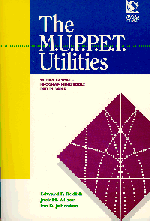 The M.U.P.P.E.T. Utilities:
The M.U.P.P.E.T. Utilities: Sample Programs
 The M.U.P.P.E.T. Utilities:
The M.U.P.P.E.T. Utilities: To download executables of the programs that are available, click on the statement "download program". These programs are DOS programs. (They can be run from Windows, but you will probably need to create a PIF file to do so.) To run them you must also have a "Borland Graphics Interface" (BGI) file appropriate for your graphics screen in the same directory as the program. For most computers today, the appropriate file is "EGAVGA.BGI". Both the program and the BGI file are contained in a "zip" file. Unzip them into the same directory using PKUNZIP or WINUNZIP.
Click here to get a screen view from Scatter (10 K)
Click here to download a copy of the executable program and BGI file (zipped). (40 K)
Click here to get a screen view from Pendulum (10 K)
Click here to download a copy of the executable program and BGI file (zipped). (45 K)
Click here to get a screen view from Quantm2 (10 K)
Click here to get a screen view from Interfere(10 K)
Click here to get a screen view from AirRes1(10 K)
Click here to download a copy of the executable program and BGI file (zipped). (35 K)
Click here to view a tutorial using AirRes1 (takes about one hour for a student to complete)
Click here to get a screen view from HarmOsc(10 K)
The program displays an animation of the masses and spring and either
Click here to get a screen view from Pulses (10 K)
Click here to download a copy of the executable program and BGI file (zipped). (40 K)
Click here to view a tutorial using Pulses (takes about one hour for a student to complete)
The program displays an animation of the masses and spring and either
A screen view from StWave.
Click here to download a copy of the executable program and BGI file (zipped). (40 K)
 MUPPET HomePage
MUPPET HomePage
 U. of Md. Computers in Physics Education HomePage
U. of Md. Computers in Physics Education HomePage
 Physics Academic Software HomePage
Physics Academic Software HomePage
Edward F. Redish
Jack M. Wilson
Ian D. Johnston